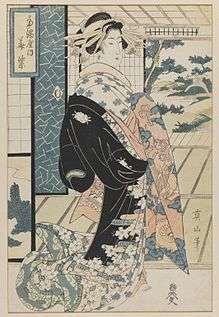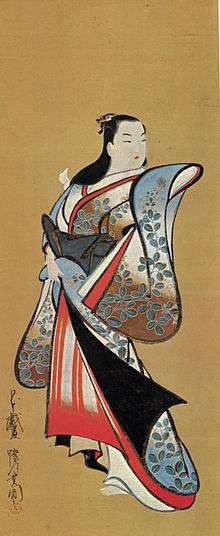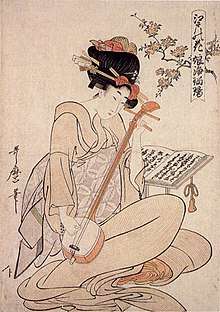Bijin
Bijin (美人) is a Japanese term which literally means "a beautiful person"[1] and is synonymous with bijyo (美女, "beautiful woman"). Girls are usually called bishōjo (美少女), while men are bidanshi (美男子) and boys are bishōnen (美少年). The term originally derives from Chinese word 美人, the word 美人 is used widely in several Asian countries including China, South Korea, North Korea, and Vietnam.


Meaning
In practice the term bijin means "beautiful woman" because the first kanji character, bi (美), has a feminine connotation.[2] The character expressed the concept of beauty by first using the element for "sheep", which must have been viewed as beautiful, and was combined with the element for "big", ultimately forming a new kanji.[3] Bijin can also be translated as "a beauty"; in a modern and informal context it means "a doll". Its modern meaning was also said to have undergone an internationalization with the term for the Moon and the a lord or ruler on high.[4] People who are called a bijin are usually considered beautiful, charming and harmonious women who wear pretty clothes.
In Mandarin Chinese, 美人 (Pinyin: měirén) also means "a beautiful woman".[5] Like Mandarin Chinese, in Korean language, 美人 (Korean: 미인; RR: Miin) means "a beautiful woman".
In Japanese art
Pictures of bijin in Japanese art are called bijin-ga. Bijin-ga is described as a genre of ukiyo-e paintings. Some of the greatest bijinga artists are Utamaro, Suzuki Harunobu and Torii Kiyonaga.[6] Until the beginning of the 20th century, bijin-ga were very popular.
Famous bijin
Akita, located on Honshu, in northern Japan, is famous for its "bijin of Akita"[7] which are characterized by their round face, clear skin[8] and high-pitched voice. Ono no Komachi, one of the Thirty-six Immortals of Poetry, was a beauty from Akita.[9]
Fukuoka, the largest city of Kyushu island in southern Japan, is also known for a large population of bijins.[10]
Some of Utamaro's favourite models have remained famous as bijin; for example Naniwaya Okita (fr), a courtesan Hanaōgi (fr), Tomimoto Toyohina (fr) and Takashima Ohisa.[11]
 Bijinga by Kitagawa Utamaro ("Flowers of Edo: Young Woman's Narrative Chanting to the Samisen", c. 1800)
Bijinga by Kitagawa Utamaro ("Flowers of Edo: Young Woman's Narrative Chanting to the Samisen", c. 1800)- Byakuren Yanagihara; one of Three Beauties of Taishō period
References
Notes
- Kasschau, Anne; Eguchi, Susumu (1995). Using Japanese Slang: This Japanese Phrasebook, Dictionary and Language Guide Gives You Everything You Need To Speak Like a Native!. Boston: Tuttle Publishing. p. 43. ISBN 9781462910953.
- Translation of kanji character 美
- Walsh, Len (2008-11-15). Read Japanese Today: The Easy Way to Learn 400 Practical Kanji. Tuttle Publishing. ISBN 9781462915927.
- Gill, Robin D. (2009). Kyoka, Japan's Comic Verse: A Mad in Translation Reader. Paraverse Press. pp. 187. ISBN 9780984092307.
- Translation of 美人 in Mandarin Chinese
- Tadashi Kobayashi, Utamaro: Portraits from the Floating World, pages 89-92
- Le Petit Futé : Les bijin d'Akita, page 379 (in French)
- Chris Rowthorn, Ray Bartlett, Andrew Bender, Michael Clark, Matthew D. Firestone, Wendy Yanagihara, Lonely Planet, Japan, page 543
- The Woman Without a Hole - & Other Risky Themes from Old Japanese, page 173
- Chris Rowthorn, Ray Bartlett, Andrew Bender, Michael Clark, Matthew D. Firestone, Wendy Yanagihara, Lonely Planet, Japan, page 666
- Images du Monde Flottant - Peintures et estampes japonaises XVIIe - XVIIIe siècles, pages 300-305 (in French)
Bibliography
- Images du Monde Flottant - Peintures et estampes japonaises XVIIe - XVIIIe siècles. (Septembre 2004) (ISBN 2-7118-4821-3)